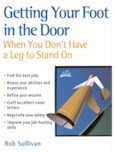As I talked about my approach, I mentioned the importance of crafting a compelling story and how it goes hand-in-hand with whatever opportunities she might want to explore. At that point, I was genuinely surprised when Donna said:
"I know you're big into the whole interviewing thing. I've spent some time on your website and I know it's a focus of yours. But the truth is, I don't need help interviewing. I'm really good in interviews. I just need help figuring out what to do with my life."
At that moment, I wondered how many other people had the same impression.
When I do sales training workshops, one of the points I emphasize is to treat every objection as a gift. After all, how often do we truly get to see a situation from another person's point-of-view? Too often, people keep their concerns and objections to themselves in an effort to avoid confrontation.
In hindsight, while it was great to hear Donna's thoughts, I may not have probed deeply enough to truly understand what gave her that impression. In any case, it was clear that from a job search perspective, she equated storytelling with interviewing. As it happens, creating a compelling story is the foundation for communication at EVERY step in the process, not just the interview. To see what I mean, let's look at a few of the essential components as it relates to Donna's situation:
SELF-ASSESSMENT
To help Donna with her goal of uncovering career options, I want to know the story of how she got where she is now.
- What decisions did she make along the way? Why?
- What were her goals?
- How, when, and why have they changed over time?
- What options has she considered?
- What options has she eliminated?
In other words, to create the next chapter in her story, I need to know all the stories and chapters that came before.
Once we identify the possibilities, it will be time to explore. As Donna learns more about each opportunity, she will need to compare the story of how each position might play out given her existing interests, skills, and experiences. Like it or not, she is not a blank slate. She has preferences and attitudes based on where she has been and how she feels about it. In other words, Donna will need to compare the story of each possible futures to see how it fits with the story that has brought her to this point.
NETWORKING
Like most clients, networking will be a great way for Donna to learn more about other career options. Here again, having a compelling story is important. People don't like to have their time wasted. Nor are they likely to make a connection for someone without a strong Reason To Believe they aren't taking a risk.
Simply put, to get help from the right people at the right time, Donna will have to make sure everyone is clear she is worth helping. The best, and perhaps only, way to communicate this is through her story.
RÉSUMÉS
After she determines what her next step will be, Donna have to tell her story in a résumé. Unfortunately, if she is like most job hunters, this is also the place it is least likely to come across.
Rather than go on for pages about why most résumés are ineffective, consider the difference between a generic laundry list of responsibilities (a typical résumé), and a document that gets the reader to think: "Wow. If she can do that for them, just think what she could do for me." Very few résumés ever achieve the latter. (If you are interested in learning more, download my Special Report, "The Secrets of Effective Résumés").
COVER LETTERS
Although most people miss this opportunity completely, one of the best places for Donna to tell her story will be the cover letter. Why? Because a cover letter can communicate something that no résumé can: Passion.
Explaining why a particular career is the Next Logical Step in Donna's professional development is a great start, but it's not enough. She has to convince potential employers she will find it exciting and energizing. For this reason, Passion is one of the three most important qualities she can communicate. In case you are curious, Initiative and Resourcefulness (an umbrella category including Problem Solving, Strategic Thinking, Idea Generation, etc.) are the others.
INTERVIEWING
While it should be obvious that the interview is one of the most important opportunities Donna will have to share her story, she may not go deep enough. Most people don't. Worse, they leave everything up to chance. How? Because they don't have a strategy. In other words, they approach the interview thinking:
"This person is going to ask me questions. My job is to do the best I can to answer them. I hope this goes well."
Hope is not a strategy.
To succeed, Donna will have to approach every interview knowing the stories she needs to share. If she takes the time to create a checklist of stories relevant to the position, she can be much more creative in how she answers the questions. She can also buy time at the end to share whatever stories weren't covered by the interviewer's questions.
Remember, stories have value only when they are shared.
Holocaust survivor Elie Wiesel put it a bit more bluntly when he said, "Not to transmit an experience is to betray it."
NEGOTIATING
People don't always think about it, but stories are also important in negotiation. For Donna, the stories will be the evidence, the Reasons To Believe, she is worth whatever additional compensation or benefits she seeks. For this to work, her story must be directly related to the value she can bring to the organization. If she doesn't provide evidence (her story), she isn't likely to achieve the results she wants.
These are just a few of the ways Donna's story has value at EVERY stage in the process. But it's not just true for Donna. It's true for you as well.

.jpg)